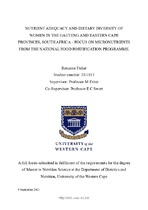Nutrient adequacy and dietary diversity of women in the Gauteng and Eastern Cape provinces, South Africa – focus on micronutrients from the national food fortification programme
| dc.contributor.advisor | Swart, Rina | |
| dc.contributor.author | Fisher, Roxanne | |
| dc.date.accessioned | 2022-01-20T09:24:33Z | |
| dc.date.available | 2022-01-20T09:24:33Z | |
| dc.date.issued | 2021 | |
| dc.identifier.uri | http://hdl.handle.net/11394/8618 | |
| dc.description | Magister Scientiae (Nutrition Management) - MSc(NM) | en_US |
| dc.description.abstract | Micronutrient deficiencies are of public health concern in South Africa. These deficiencies affect pregnancy outcomes, growth, functional and cognitive development of children and, the health and productivity of women. As an intervention, the South African government implemented the National Food Fortification Programme (NFFP), which was mandated in 2003 and according to which, the staple foods consumed by most of the population e.g. maize meal and wheat flour (and thus bread) are fortified with a premix of thiamin, niacin, riboflavin, vitamin A, folate, vitamin B6, iron and zinc. There is limited data which looks at the contribution fortified staple food to the dietary intakes and measures of nutrient assessment among South African women of reproductive age (WRA). | en_US |
| dc.language.iso | en | en_US |
| dc.publisher | University of Western Cape | en_US |
| dc.subject | Dietary diversity | en_US |
| dc.subject | Food fortification | en_US |
| dc.subject | Fortified staple food | en_US |
| dc.subject | Nutrient adequacy | en_US |
| dc.subject | Household hunger | en_US |
| dc.subject | Eastern Cape province | en_US |
| dc.title | Nutrient adequacy and dietary diversity of women in the Gauteng and Eastern Cape provinces, South Africa – focus on micronutrients from the national food fortification programme | en_US |
| dc.rights.holder | University of Western Cape | en_US |

